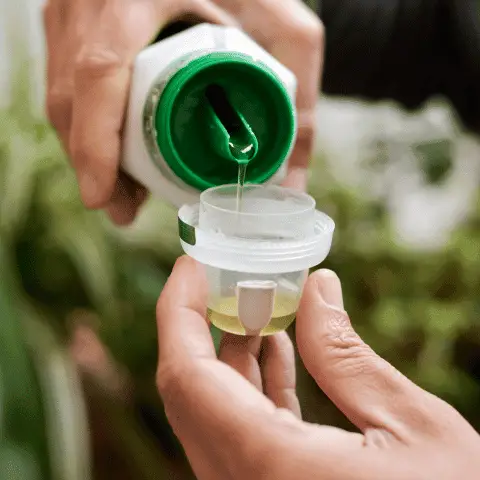When it comes to keeping our house plants healthy and nourished, the question of whether or not we need fertilizer is often at the forefront of our minds. After all, we want them to thrive and look as good as possible – but do we really need to use a specialized product in order for them to survive?
In this blog post, I’ll be exploring both sides of this debate and delving into the hidden world of fertilizer: its composition, why certain plants benefit from it more than others, how much you should apply each time – but first and foremost, answering that lingering question of ‘Do plants really need fertilizer’? So if you’re unsure about what route you should take with your houseplant parenting routine, stay tuned for an informative read!
Do we need to feed our indoor plants with fertilizer?
Plants are one of nature’s greatest wonders – they require minimal care while providing oxygen and cheer around us. Sometimes we mistakenly think that all our plants need to survive is a bit of sun, earth, and water.
However, no matter how resilient your plants seem, they need some nourishment from time to time to keep performing their best. Fertilizers are essential for helping all types of plants achieve their fullest potential, so if you’ve been avoiding them up until now, it’s time to reconsider why fertilizer should be part of your regular plant care routine!
Will our indoor plants survive without fertilizer?
Have you ever wondered if plants truly need fertilizer to survive? Well, the answer might surprise you! While it is true that fertilizers provide essential nutrients for plant growth, not all plants require them to live for a long time. In fact, some plants can grow for years with only water and sunlight. Succulent, for instance, usually do not require fertilizers.
However, it’s important to remember that fertilizer is still valuable for maintaining healthy and vibrant plants. More so if it is a flowering plant, so while it’s possible for a plant to survive without it, a small amount of fertilizer can go a long way in promoting growth and ensuring your plant stays happy and healthy for years to come.
Before we get into the details about plant fertilizers, let’s take a step back and talk about exactly what fertilizer is.
What is exactly a plant fertilizer? What’s its composition?
Plant fertilizers have been a trusted tool in agriculture, horticulture, and gardening for centuries. These nutrient-rich substances come in various forms, from compost and manure to liquid and pellets. However, it’s important to note that not all fertilizers are created equal. Each plant has its specific needs, and the right fertilizer can make all the difference.
Fertilizers primarily comprise three essential nutrients – nitrogen, phosphorus, and potassium.
As a rule of thumb, nitrogen is for foliage growth, phosphorous helps the roots, and potassium increases healthy blooms. To further enhance soil health, fertilizers may also contain other important nutrients such as zinc and manganese.
When it comes to finding the right type of fertilizer for your plants, the options can seem overwhelming. With so many choices available on the market, it can be difficult to know where to start. From organic to synthetic, liquid to granular, there are plenty of options to choose from.
So, let’s explore the different types of fertilizers available and find the best one that suits your needs.
Granular fertilizers are a highly effective form of plant nutrition that comes in the form of small pellets. These pellets can be slow-releasing, allowing for a consistent and reliable supply of nutrients to your plants over an extended period of time. They are also easy to use, simply sprinkle them around the base of your plants and let nature take its course. It’s important to choose the right type of granular fertilizer for your needs, as many different varieties are available. Whether you’re an avid gardener or a professional landscaper, granular fertilizers can provide the nutrients your plants need to thrive.
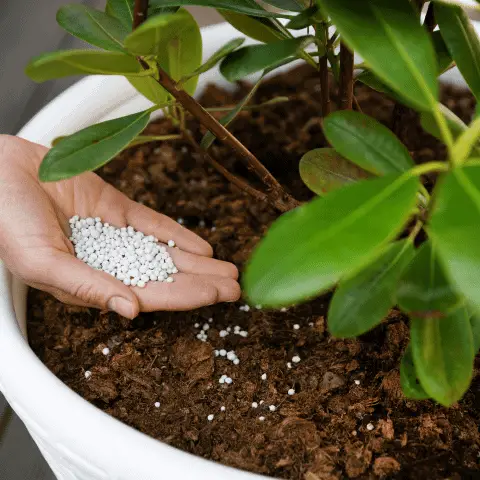
Liquid fertilizer is a nutrient-rich solution that can be easily applied to plants to promote growth and boost overall health. It is an excellent choice for those who prefer a quicker uptake of nutrients by their plants than traditional granular fertilizers. But, we must exercise caution when applying liquid fertilizers to our garden areas, as over-application can lead to the burning of plants. Therefore, it is essential to control the amount of liquid fertilizer we use and how frequently we use it by following the correct application guidelines and using measuring devices. In summary, using liquid fertilizer can be incredibly beneficial to plants, but it needs to be used with care and control to achieve optimal results.
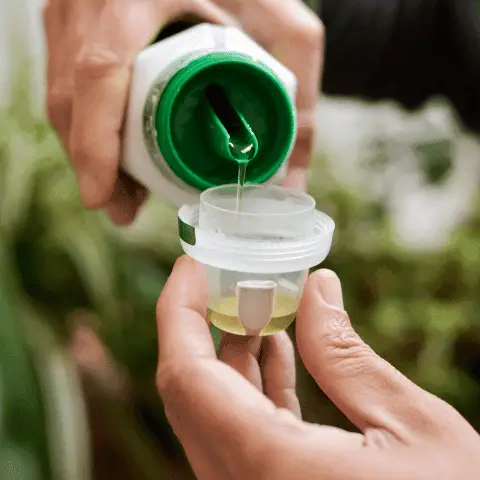
Compost: Organic in nature, compost is made from decomposed organic matter and is a great alternative to synthetic fertilizers. Did you know you can create a homemade fertilizer with just a few simple ingredients? Nitrogen, potassium, and phosphorous, the key nutrients needed for plant growth, can all be found in a home compost.
A kitchen scraps-only compost, or use of earthworm farming, can help reduce waste while enriching the soil with necessary nutrients. Home compost is worth considering if you’re searching for an environmentally-friendly and affordable garden fertilizer. By composting at home, you’ll have a fresh, healthy, and cost-effective source of fertilizer and an opportunity to contribute to a more sustainable lifestyle.
Here is an idea for a compact composter, a simple and effective solution, especially if you don’t have much space in your yard.
Or perhaps you want to start farming earthworms? If you’re curious about the fascinating world of earthworm farming, I invite you to read my latest article on the subject. (And, yes they are gross but… at least they don’t smell!) Give it a try and see for yourself the amazing benefits of composting!
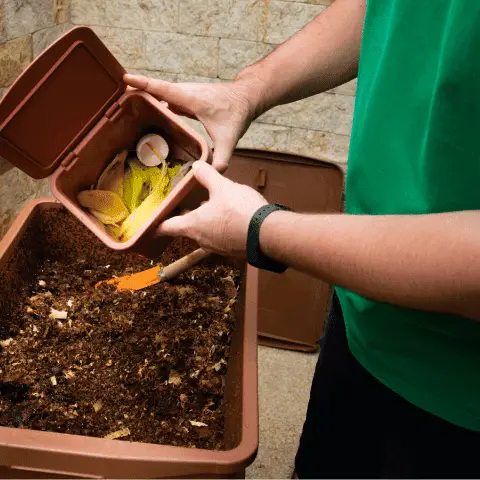
How often should we fertilize our houseplants?
If you’re a plant parent, you probably already know that a little love and attention can go a long way in keeping your houseplants healthy and happy. But when it comes to fertilizing, it can be tricky to figure out just how often you should be doing it. The general rule of thumb is to fertilize your plants once a month during their growing season (which is typically spring and summer), but it’s important to pay attention to your individual plant’s needs. Over-fertilizing can be just as harmful as under-fertilizing, so you should always follow the specific instructions on your fertilizer product and adjust accordingly based on your plant’s individual needs. With a little bit of research and some trial and error, you’ll be able to find the perfect balance for your beloved green friends.
What are the signs that our plants need feeding?
We plant owners want our green friends to stay healthy and happy. However, sometimes it can be challenging to know when our plants require more nutrients. Luckily, there are several telltale signs that your plant needs feeding. One of the most common signs is yellowing or wilting leaves, which can indicate a lack of essential minerals. Another sign is slow or stunted growth, which can be a sign that your plant is not receiving enough energy to thrive. Lastly, if you notice that your plant’s soil is dry and crumbly, it may need more water and food. By keeping an eye out for these signs, you can take the necessary steps to ensure your plant stays healthy and vibrant for years to come.
Let me tell you a story about the geraniums on my balcony. I started off thinking that sunlight and water were enough to take care of them, but boy, was I wrong. After the first year, they looked sad, dry, and sickly. It wasn’t until I remembered to start feeding them that they began to regain their beauty. Moral of the story: don’t forget to feed your plants! Here is a picture of them.
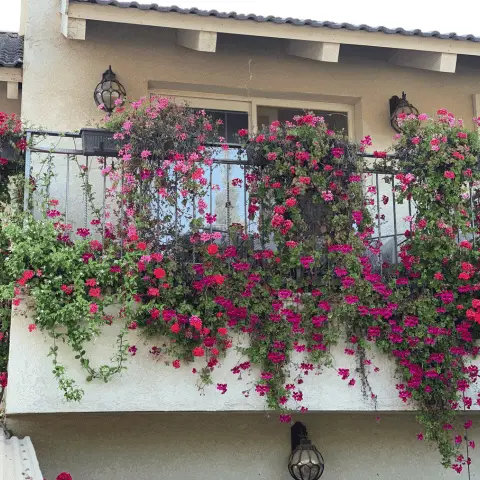
One essential nutrient for blooming flowers is potassium. This nutrient helps to promote strong, healthy growth and encourages beautiful blooms. By providing your flowers with potassium-rich fertilizer, you can help ensure that they reach their full potential and have a luscious, vibrant appearance. I personally chose a liquid fertilizer because I wanted faster results. I am very fond of this product.
How do we choose the right fertilizer?
Choosing the perfect fertilizer for your plants can seem like a daunting task, but with a few simple tips, it can be a breeze. First and foremost, it’s crucial to understand the needs of your specific plant.
Take note of whether it is a flowering plant, a fruit-bearing plant, or if it requires a specific pH level in the soil. From there, you can begin to narrow down your options. It’s also important to consider the fertilizer’s nitrogen-phosphorus-potassium (N-P-K) ratio. This ratio indicates the percentages of each nutrient and can help you choose a fertilizer that best suits your plant’s needs.
For instance, giving a plant too much potassium may lead to nutrient burn, which can cause leaves to become brown and crispy. On the contrary, if we overdose the plant with nitrogen fertilizer, it can lead to rapid and excessive leafy growth at the expense of blooming and fruit production. Additionally, too much nitrogen can cause your plant’s leaves to become vulnerable to pests and diseases.
Considering these factors, you can select a fertilizer that will provide your plant with the nutrients it needs to thrive.
How long do the nutrients from the plant nursery potting mix last?
Although there is no definitive answer, it is generally agreed upon that the nutrients in potting mix will last for several months (sometimes years), depending on a variety of factors such as the type of plant, its growth rate, and how frequently it is watered. Gardeners are recommended to regularly replenish potting soil and supplement it with additional nutrients to ensure vigorous growth and optimal plant health. It’s important to be aware of the ingredients in the soil and the plant’s nutritional requirements to determine when it’s time to add fertilizers.
In conclusion, applying fertilizer to your houseplants is essential for their good health. Select your fertilizer carefully by reading the labels and analyzing the brand and type of plant food needed. Consider doing some research before purchasing plant food to understand how much to put in and how often it needs to be applied, select a formula that’s right for the plants you own, and take into account local life weather when planning fertilizer use. Many different variables are involved in selecting and applying the right fertilizer, so it’s important that you consult a credible source or expert before making any decisions when figuring out what should work best for your houseplant. Remember, successful houseplant gardening requires patience and diligence – don’t forget this important step!
Some of the links above are affiliate links, meaning at no additional cost to you, I will earn a commission if you click through and make a purchase.
Other articles you might be interested in:
6 Houseplant Accessories You Need (And What To Pass On)
How To Choose The Right Metal Plant Stand

